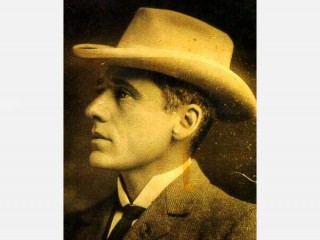
Andrew Paterson biography
Date of birth : 1864-02-17
Date of death : 1941-02-05
Birthplace : "Narrambla", near Orange, New South Wales, British Empire
Nationality : Australian
Category : Famous Figures
Last modified : 2010-12-03
Credited as : Folk Poet, The Banjo,
Andrew Barton Paterson was an Australian folk poet popularly known as "Banjo" Paterson from his pen name, The Banjo. His swinging rhythms captured the atmosphere of the land, life, and humor of Australia's people.
The son of a grazier, Andrew Paterson was born at Narrambla near Orange, New South Wales, on Feb. 17, 1864. While attending Sydney Grammar School he lived with his grandmother, a writer of verse and a member of Sydney's literary set. The lad spent school vacations on his father's property in the Yass district; here he absorbed the frontiersman's lore and developed a love of the outdoors. At 16 he entered Sydney University; when he graduated, he practiced law in Sydney.
Adopting the name "The Banjo" from a racehorse, Paterson began contributing narrative-type verse to the Bulletin of Sydney, then establishing itself among men living secluded lives in the hinterland. He became a leading exponent of the "bush ballad," writing about horsemen, drovers, shearers, and other outdoorsmen, with an emphasis on action and comradeship.
"Clancy of the Overflow"—a rollicking verse with "the true jingle of the snaffle and spur"—appeared in 1889; it was among Paterson's most durable verses. A book of ballads, The Man from Snowy River and Other Verses (1895), achieved immediate success. While on a visit to Winton in western Queensland, in 1895 Paterson wrote the ballad "Waltzing Matilda" to an old English marching tune; it was to move through the status of a national folk song to become Australia's unofficial national anthem.
Although his output was uneven in quality and generally inferior to the best of Henry Lawson, Paterson evoked the feeling of the campfire and the open land and established himself as the most popular of the Australian balladists. In practically all his writing he emphasized adventure and good fellowship, and he colored his verse with humor and irony. His characters possess vitality and an optimistic approach. Lawson was among those who considered that Paterson's ballads gave a wholly idealized picture of bush life; certainly Paterson's view was colored by association with men of wealth, and although he was not oblivious to social tensions and the hard life of the underdog, he showed the compassion of a considerate observer rather than the deep social involvement of Lawson.
In 1899 Paterson left law practice for journalism. He published a collection of verse (1902), a novel, An Outback Marriage (1904), and a collection of traditional ballads, Old Bush Songs (1904). In 1908 he decided to return to the rural scene; he bought a grazing property and lived the outdoor life, writing intermittently.
Enlisting for war service in 1915, Paterson was abroad until 1919, when he returned to Sydney. He wrote Saltbush Bill, J.P., and Other Verses (1917) and Collected Verses (1921); the latter enjoyed wide popularity. He died at Sydney on Feb. 5, 1941.
An appreciation of Paterson's work is given in Archie J. Coombes, Some Australian Poets (1938). Edmund M. Miller, Australian Literature, edited, with a historical outline and descriptive commentaries, by Frederick T. Macartney (1938; rev. ed. 1956), contains a concise biography of Paterson which quotes characteristic verses. An appraisal of the various aspects of Paterson's talent and an assessment of the significance of his ballads in the national literary movement can be found in Henry Mackenzie Green, Australian Literature, 1900-1950, vol. 1 (1963).
Roderick, Colin Arthur, Banjo Paterson: poet by accident, North Sydney: Allen & Unwin, 1993.
Semmler, Clement, The Banjo of the bush: the life and times of A.B. "Banjo" Paterson, St. Lucia, Qld., Australia: University of Queensland Press; Lawrence, Mass.: Distributed in the USA and Canada by Technical Impex Corp., 1984, 1974.
















